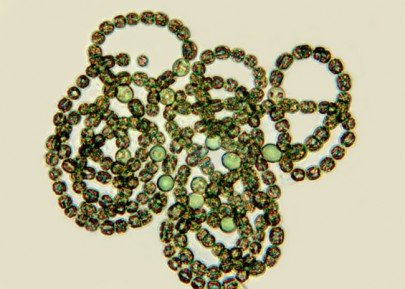Cyanobacteria
In this section

Anabaena, Tomahawk Lagoon, X640.
Cyanobacteria are also known as "blue-green algae", due to the colour of their cytoplasm in the absence of shielding pigments. However, they are fundamentally different from other algae in this guide, because they are prokaryotic (as are all bacteria). This means that they lack chloroplasts, nuclei, and other membrane-bound organelles. They do, however, photosynthesise - generate sugars and oxygen from CO2 and water using sunlight energy - by the same biochemical process as the eukaryotic algae. Instead of being bound in chloroplasts, their thylakoid membranes - the sites of light harvesting - are free in the cyotplasm. Therefore, they more closely resemble the chloroplasts of red and green algae than they do the cells of eukaryotic algae, and several lines of evidence confirm that cyanobacteria and chloroplasts have a close evolutionary relationship. It is generally accepted that ancient ancestors of modern cyanobacteria were engulfed by non-photosynthetic eukaryotes, an arrangement that ultimately led to modern chloroplasts.
An extremely significant additional ability of many cyanobacteria is nitrogen fixation (the fixation of atmospheric nitrogen gas into nitrogenous organic molecules that can be used by cells). This is essential for nutrient cycling, and is an exclusively prokaryotic invention, although it has been recruited by some eukaryotes (including the diatoms Epithemia and Rhopalodia) through various kinds of symbioses with bacteria.
Some cyanobacteria are well known to produce toxins. Their mass proliferation in a waterbody is therefore cause for considerable concern.
Cyanobacteria comprise four main morphological types. These are unicellular, colonial, and two types of filamentous forms. The filamentous forms are split into those with specialised nitrogen-fixing cells (heterocytes), and those without. Among these four groups, only the heterocyte-formers are thought to be a cohesive group in evolutionary terms - the other types of habit have evolved multiple times.
Examples of these groups are Cyanothece (a unicell), Microcystis (a colony forming genus), Phormidium (a non-heterocytous filament), and Anabaena (a heterocytous filament). Note that the latter three of these are all documented to have produced toxins in freshwaters.
Some filamentous cyanobacteria producing branches of various kinds. So-called "false branching" is a situation in which the cells in the new branch are not continuous with those in the old branch; this can happen in different ways. In Stigonema and its near relatives, true branching occurs, and visible connections between cells. Since this genus is also heterocytous, this is an example of complexity to rival (or surpass) many eukaryotic algae - remarkable indeed given the common perception of bacteria as "simple" and "primitive".

![[Ammatoidea], X1000.. Photo: Phil Novis, Manaaki Whenua](/assets/Tools-And-Resources/Identification/algae/ammatoidea_phil1000__FillMaxWzMwMCwyMDBd.jpg)
![[Anabaena], Tomahawk Lagoon, X640. Photo: Otago Regional Council & Manaaki Whenua](/assets/Tools-And-Resources/Identification/algae/anabaena2__FillMaxWzMwMCwyMDBd.jpg)
![[Aphanocapsa], Waipori River, X25. Photo: Otago Regional Council & Manaaki Whenua](/assets/Tools-And-Resources/Identification/algae/aphanocapsa25__FillMaxWzMwMCwyMDBd.jpg)
![[Chamaesiphon], Tokomairiro River, X400. Photo: Otago Regional Council & Manaaki Whenua](/assets/Tools-And-Resources/Identification/algae/chamaesiphon400__FillMaxWzMwMCwyMDBd.jpg)
![[Chroococcus], Lake Rotoiti, X640. Photo: Otago Regional Council & Manaaki Whenua](/assets/Tools-And-Resources/Identification/algae/chroococcus__FillMaxWzMwMCwyMDBd.jpg)
![[Coleodesmium], Kakanui River, X9. Photo: Otago Regional Council & Manaaki Whenua](/assets/Tools-And-Resources/Identification/algae/coleodesmium3__FillMaxWzMwMCwyMDBd.jpg)
![[Cyanothece], X1000. Photo: Phil Novis, Manaaki Whenua](/assets/Tools-And-Resources/Identification/algae/cyanothece_phil1000__FillMaxWzMwMCwyMDBd.jpg)
![[Dichothrix], Moke Creek, X15. Photo: Otago Regional Council & Manaaki Whenua](/assets/Tools-And-Resources/Identification/algae/dichothrix__FillMaxWzMwMCwyMDBd.jpg)
![[Microcystis] (sewage pond), X400. Photo: Manaaki Whenua](/assets/Tools-And-Resources/Identification/algae/microcystistrc__FillMaxWzMwMCwyMDBd.jpg)
![[Phormidium], X640. Photo: Otago Regional Council & Manaaki Whenua](/assets/Tools-And-Resources/Identification/algae/phormidium4__FillMaxWzMwMCwyMDBd.jpg)
![[Stigonema], X40. Photo: Phil Novis, Manaaki Whenua](/assets/Tools-And-Resources/Identification/algae/stigonema_phil40__FillMaxWzMwMCwyMDBd.jpg)